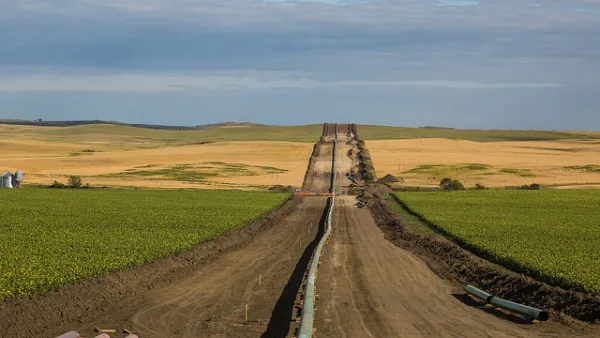Comparisons to Wounded Knee have been common as a growing number of Native Americans are gathering in North Dakota to protest the construction of a new crude oil pipeline.

William Yardley reports from the scene of a growing protest against the proposed Dakota Access oil pipeline, which would "carry more than 400,000 barrels of crude oil a day from the Bakken region of western North Dakota across South Dakota and Iowa to connect with an existing pipeline in Illinois."
"The 1,100-mile pipeline, which is estimated to cost $3.7 billion, is nearly halfway complete," adds Yardley. "But construction on a section that would sink beneath the Missouri River, just north of the reservation of the Standing Rock Sioux, has been halted under orders from the sheriff of Morton County, Kyle Kirchmeier."
The sheriff ordered the halt in response to a growing number of Native Americans, gathering to protest the construction. "What began with a handful of natives establishing a prayer camp along the river this spring has now drawn international environmental groups and prompted Hollywood celebrities, including Susan Sarandon and Shailene Woodley, to join them, whether here or in a protest last week in Washington, D.C., or on social media."
The article goes on to detailing the work of Earthjustice to build a legal case against the project, and the rulings from the United States District Court that could impact the project. Judge James A. Boasberg has promised a ruling no later than September 9 on a request to stop construction. The article also includes personal stories from some of the Native Americans protesting the project.
FULL STORY: With echoes of Wounded Knee, tribes mount prairie occupation to block North Dakota pipeline

National Parks Layoffs Will Cause Communities to Lose Billions
Thousands of essential park workers were laid off this week, just before the busy spring break season.

Retro-silient?: America’s First “Eco-burb,” The Woodlands Turns 50
A master-planned community north of Houston offers lessons on green infrastructure and resilient design, but falls short of its founder’s lofty affordability and walkability goals.

Delivering for America Plan Will Downgrade Mail Service in at Least 49.5 Percent of Zip Codes
Republican and Democrat lawmakers criticize the plan for its disproportionate negative impact on rural communities.

Test News Post 1
This is a summary

Test News Headline 46
Test for the image on the front page.

Balancing Bombs and Butterflies: How the National Guard Protects a Rare Species
The National Guard at Fort Indiantown Gap uses GIS technology and land management strategies to balance military training with conservation efforts, ensuring the survival of the rare eastern regal fritillary butterfly.
Urban Design for Planners 1: Software Tools
This six-course series explores essential urban design concepts using open source software and equips planners with the tools they need to participate fully in the urban design process.
Planning for Universal Design
Learn the tools for implementing Universal Design in planning regulations.
EMC Planning Group, Inc.
Planetizen
Planetizen
Mpact (formerly Rail~Volution)
Great Falls Development Authority, Inc.
HUDs Office of Policy Development and Research
NYU Wagner Graduate School of Public Service



























